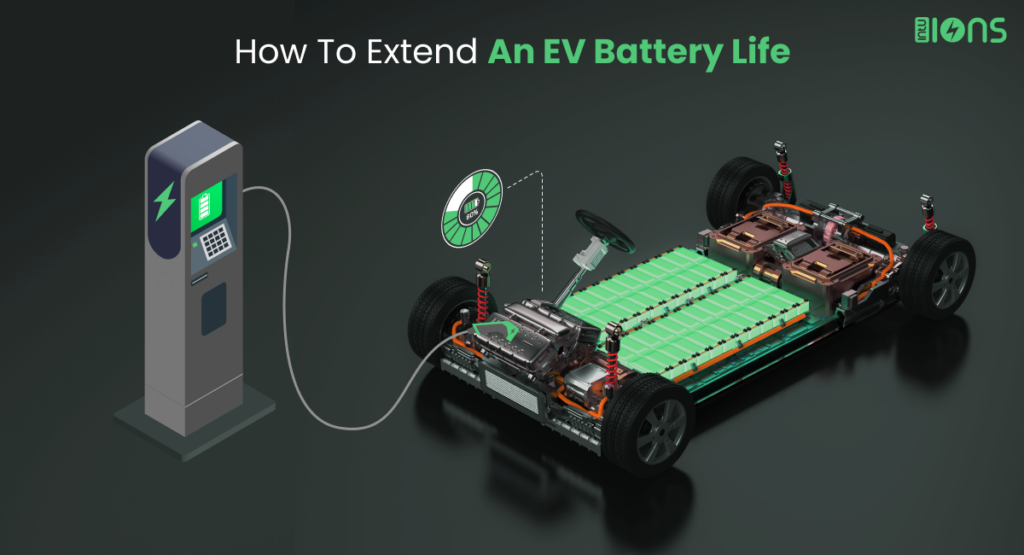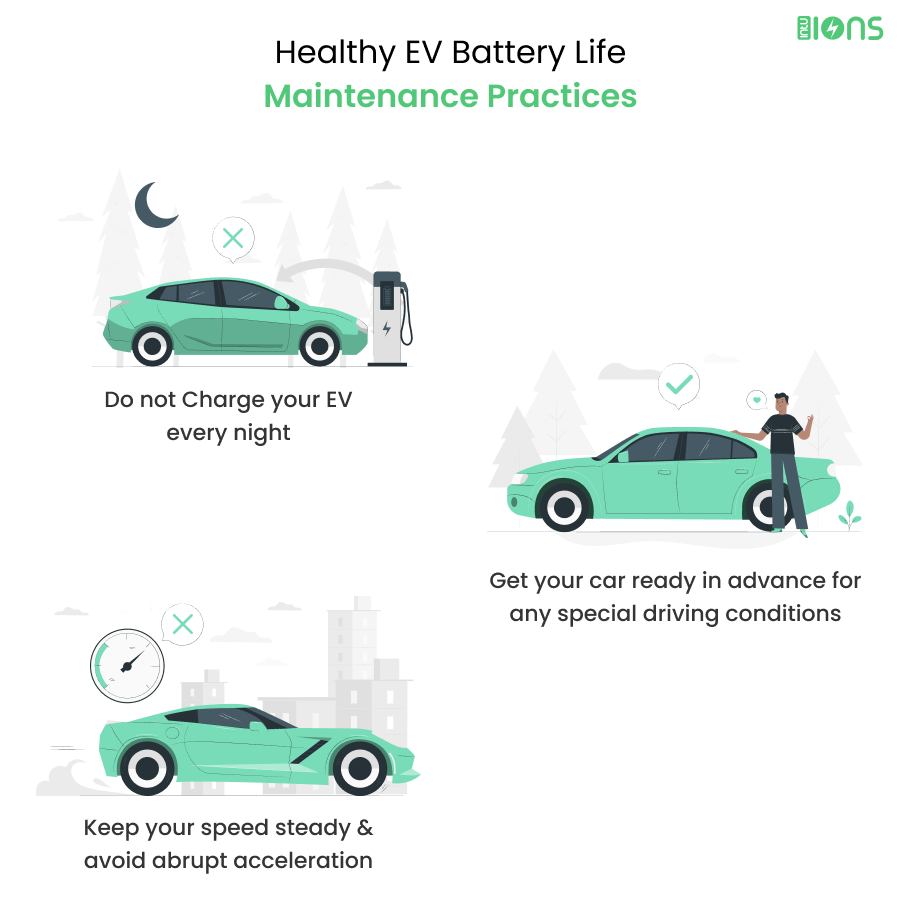How To Extend An EV Battery Life

An EV battery in the best condition will have a longer lifespan, which is definitely of value when you decide to sell. Plus, you can avoid unnecessary recharging expenses so often. In this article, we will study everything there is to know about EV battery life, how an EV battery works, how to minimize the degradation of an EV battery, and the best ways to maintain it:
We live in an age where driving Electric Vehicles (EVs) is no longer a dream. With every passing day, we see more and more EVs on the road, creating less noise and air pollution. What a bliss, is it not?! However, despite lower EV prices, consumers are still getting used to the idea of purchasing an EV.
Moreover, the maintenance of EVs is already a huge point of discussion. The truth is even though EVs might not require new spark plugs or regular oil chances, they still need to be maintained. You see, EVs run on battery, monitoring which is just as crucial as an oil-guzzling vehicle’s engine.
So, how do you keep an EV battery healthy? Whether you are planning to buy or manufacture an EV, you would know that its battery maintenance is essential to EV ownership. A healthy battery means you can store more power, which directly translates to a driving range.
An overview of the EV battery life
An Electric Vehicle obtains its power straight from a large pack of batteries, unlike internal combustion engine cars, which get their energy from burning gasoline or fuel.
These resemble an enlarged version of the Lithium-ion (Li-ion) battery in your smartphone, however, Electric Vehicles use packs made up of thousands of individual Li-ion cells that cooperate to power the vehicle.
Electricity is utilized to change the chemical composition of the batteries while the car gets charged. These modifications are then reversed when the vehicle is in motion to create electricity that powers it.
Due to their high energy density, Lithium-ion batteries are the best choice for electric cars since they can produce more power relative to their size. EVs are more straightforward and effective than ICE vehicles because they only use their batteries for power.
EV prices have decreased by 89% since 2010 due to the quick advancements in battery technology in recent years. EV battery cells are more durable than you might imagine, just like your smartphone, tablet, and laptop batteries.
By 2040, Electric Vehicles are anticipated to account for more than two-thirds of all passenger car sales globally, according to BloombergNEF.
Experts anticipate that EVs will soon be as inexpensive to construct as ICE vehicles because Lithium-ion battery costs have dropped by 97% in the past 30 years. Electric vehicles are now cheaper than traditional cars in the long run.
An electric car battery life span is typically around 10 years or more, although this can vary depending on how often you charge your car and how you drive it.
So, how does an EV battery work?
The basic idea of a Lithium-ion battery is to circulate electrons by establishing a difference in potential between two electrodes, one negative and the other positive, which are submerged in an electrically conductive liquid, or electrolyte.
During the discharging phase of a battery’s operation, electrons accumulated in the negative electrode are liberated and moved to the positive electrode via an external circuit.
When the battery is being charged, on the other hand, the energy provided by the charger transfers the electrons back from the positive electrode to the negative.
The battery types differ in ion types, electrode materials, and related electrolytes. For instance, a combustion engine is typically powered by a 12-volt lead-acid battery that uses lead-based electrodes and an electrolyte containing lead ions. The Lithium-ion battery uses Lithium ions (Li+), hence the name given to this technology.

Every battery in the USA has a warranty lasting at least eight years or up to 10,000 miles. However, you should always become familiar with the warranty conditions because there can be further caveats.
There will also be differences in battery performance and longevity between manufacturers and models. For instance, whereas Hyundai offers lifetime coverage, KIA offers a ten-year battery pack warranty.
Batteries for Electric Vehicles typically last 10 to 20 years, however, some variables may shorten that time. For example, since heat does not work well with EVs, batteries may deteriorate more quickly in hotter climates.
Additionally, because the charging procedure at a Level 3 station is too quick, the battery may overheat as a result. Performance and longevity may suffer as a result of this process.
Temperature, usage frequency, and time are the leading causes of EV battery degradation. The lifespan of an EV battery is significantly impacted by storage and operation temperatures; generally speaking, warmer climes have a negative impact.
The battery gradually loses its maximum potential as it undergoes EV charging cycles—discharged while in use and recharged when plugged in. However, simply not using or charging your EV battery does not guarantee that it will last indefinitely. Calendar degradation is the process of the battery deteriorating over time.
The University of Michigan battery study considered both cycle and calendar aging with use. It also concentrated on the two main types of battery deterioration: capacity fade (where the amount of energy that can be stored in amp-hours decreases) and power fade (where the battery’s internal resistance in ohms rises, slowing the rate at which energy can be injected into or drawn out of the battery).
Power fade affects an Electric Vehicle’s driving performance, including acceleration, gradability, and the speed at which it can be recharged, either by the brakes or a charger. Capacity fade affects an Electric Vehicle’s range and fuel consumption.
How to minimize the degradation of your EV battery
Any battery will eventually lose some “life” due to the natural process of battery deterioration. However, because the battery in an electric car will be used by you for a very long period, maintaining it is much more crucial. In addition, we must use our electric automobiles as efficiently as possible.
Additionally, many batteries used in Electric Vehicles have a “second life” when their utility for propelling four wheels has worn out. You could utilize one Lithium-ion battery created for an EV for decades because these batteries are frequently used for energy storage.
When various reactions remove Lithium ions from circulation, there is a loss of Lithium inventory (LLI). When Lithium is plated onto the anode as a protective “solid electrolyte interphase” (SEI) layer during the initial charging cycles of a new battery’s life, it continuously depletes roughly 10% of the Lithium that is accessible.
Loss of active material (LAM) often occurs when the electrodes deteriorate because there are fewer places for the Lithium ions to attach. Whichever of the aforementioned is worse will impact a capacity fade, while both modes have a cumulative effect on power fade.
When the electrode volume varies by up to 10% due to “lithiation” and “delithiation,” mechanical tension is present. This swelling and contracting may lead to “exfoliation” and cracking of the SEI, which may remove additional Lithium from circulation as it re-plates.
Top six ways to maintain an EV battery
Naturally, we want to extend the battery’s life as much as possible because doing so helps us and the environment. Fortunately, you can take steps to lengthen your car’s battery life. Here are some pointers for keeping an electric car battery in good condition.
1. Get as much range out of the EV battery as you can
Lithium-ion batteries are rated for a specific number of EV charging cycles – a complete charge and discharge of the battery. The more charge cycles a battery has, it will likely experience degradation with time. It is the same logic as a laptop battery charger.
Limiting the number of charge cycles could be better advice. But you can drive your EV economically and ensure you get as much mileage from the battery as possible before charging it. Monitoring your battery charge will only elongate its working condition.
In addition, it is important for end users to drive the EV in “eco mode” switched on and minimize the excess weight in the vehicle. They must also avoid driving at high speeds and leverage regenerative braking, and accelerate and brake slowly and smoothly.

2. Do slow charging
While charging at the fastest rate may sound desirable, faster chargers (50-350 kW) might put the battery under more stress and shorten its lifespan. Faster chargers can damage your car’s battery but are generally safe. It produces excessive heat and draws excessive electricity from the battery, which is why. This is not the purpose of your Electric Vehicle.
Research shows that a 10% difference in range capacity will result after eight years of fast charging over ordinary charging. That is the difference between 450 miles and 500 miles. That might not sound like much, but to some people, that could represent a week’s worth of commuting.
To meet business demands and use infrastructure, some fleet operators require their drivers to use quick chargers. These chargers are faster than indeed required. Investigate your options; a “rapid” charger that operates at 7 to 22 kW is frequently more than sufficient and less likely to result in battery problems over time.
3. Check battery health regularly
How to charge an EV battery, you ask? Check the physical state, battery life remaining, and current charge. Your battery needs to be repaired right away if it has rust, leakage, or any other kind of mechanical damage. By doing this, you can avoid unpleasant battery-related surprises in the future.
4. Maintain optimum State of Charge
Although it may seem paradoxical, there are better options than a full charge for your battery’s long-term health. A battery’s life will be shortened by heating caused by overcharging.
Finding out how many miles you go daily and what battery % you require is vital. If you choose the perfect EV charger, it will adapt to the driving habits and stop charging at the correct percentage, which is not 100%.
You can avoid premature battery aging by maintaining charge levels between 20 and 80%. The most important thing is to ensure you avoid a 100% charge. The magic percentage is often 75%.
5. Minimize exposure to extreme temperatures
Very cold and very hot temperatures both harm battery performance. As an EV owner, your responsibility is to reduce how often your car is exposed to high heat.
Your battery will function poorly when it is cold outside. Potentially declining factors include range, performance, and charging time. When it gets below freezing, even gas-powered car batteries succumb. All of this is possible because of the battery’s internal chemistry. Slower reaction times are experienced as the air cools.
It happens when you realize that it is hot outside and how your car behaves. Within the battery, harm is being done. Your EV has a thermal protection system that can assist shield you from extreme heat.
In rare circumstances, a battery that is too hot will not charge. This prolongs the life of your battery but it may result in a car only partially charged when you wake up. Batteries lose capacity as a result of internal material degradation when they become heated. In other words, a fully charged battery is less fully charged after being subjected to high heat.
6. Plan short drives
Electric Vehicles are moving too quickly to maintain a modest speed. Give your battery some time to cool out after a quick joyride before connecting it. After you misuse the engine for amusement, your battery will probably be warm.
The battery gets hot while charging. Heat is a battery’s worst enemy, as we all already know. Let it cool down in your garage for 30 to 60 minutes before plugging the battery back in.
Know your EV battery charging cycle
Battery health is based on crucial battery cycles. A battery is fully charged to 100% after being discharged to a particular level during one battery, or charge cycle as it is commonly referred to. A complete 0–100% determines a cycle, but not in the strictest sense.
For instance, if your battery decreases to 20% and you charge it to 100%, the next day it drops to 70% and you charge it again to 100%. The battery charges up by 110% during this period, or one charging cycle plus an additional 10%. Therefore, you can finish a cycle using many charging cycles rather than having a literal range of 0 to 100%.
What makes a charge cycle significant, then? The frequent charge and discharge tend to wear down the battery and the chemicals inside, lowering its capacity and deteriorating performance. Because of this, it is always stated that a battery has a limited amount of charge.
Lithium-ion batteries, the technology that typically makes up the battery pack for most EVs, have a lifespan of 400–5000 battery cycles, or roughly 5–6 years of regular charging for EVs, which is more than enough for anyone using one. More chemically complex batteries with higher energy density will be produced as technology advances.
Healthy EV battery life maintenance practices
Calendar aging is not the only reason why an EV battery’s battery will deteriorate. The state of battery charge and the exposure to extreme temperatures can negatively hamper the battery life. To get the most out of your EV battery, it is essential to follow some basic best practices:
1. Do not charge your EV every night
Every time your battery charges, you stress the battery, whether you are merely topping it off by a few percent or fully charging the vehicle. As a result, the battery’s capacity is slightly diminished. You should not plug your car in every night to avoid this escalating over time. Your battery life can be increased if you only charge your car when required rather than plug it in as soon as you arrive home.
2. Keep your speed steady and avoid abrupt acceleration
Rapid battery drain brought on by sudden acceleration or braking compromises performance. In addition to difficult driving circumstances, aggressive driving or quick acceleration will only cause the battery to discharge more quickly. Thus, modest speed and safe driving conditions prevent the battery from depleting rapidly.

3. Get your car ready in advance for any special driving conditions
As a best practice, recharge your EV in the evening or as needed rather than letting the battery get very low. Top-offs rather than complete 0–100% recharging cycles can extend the life of your EV battery. Smart charging stations also enable you to manage the battery’s charge level and fill it only as high as a predetermined threshold.
Over to you
If you are stepping in the world of EVs and want to know everything there is to know about the industry, you have come to the right place. We at IntuThings can help you develop robust and innovative IoT products in the EV battery space that stand the test of the time. We aim to align our solutions with your core business functionality. Want to have a chat about your next big IoT idea? We are all ears. Get in touch with us today.
